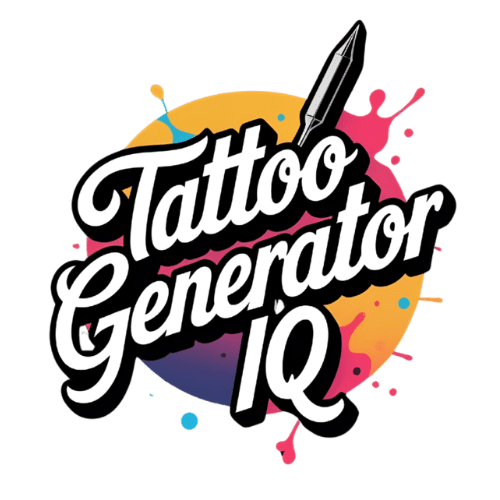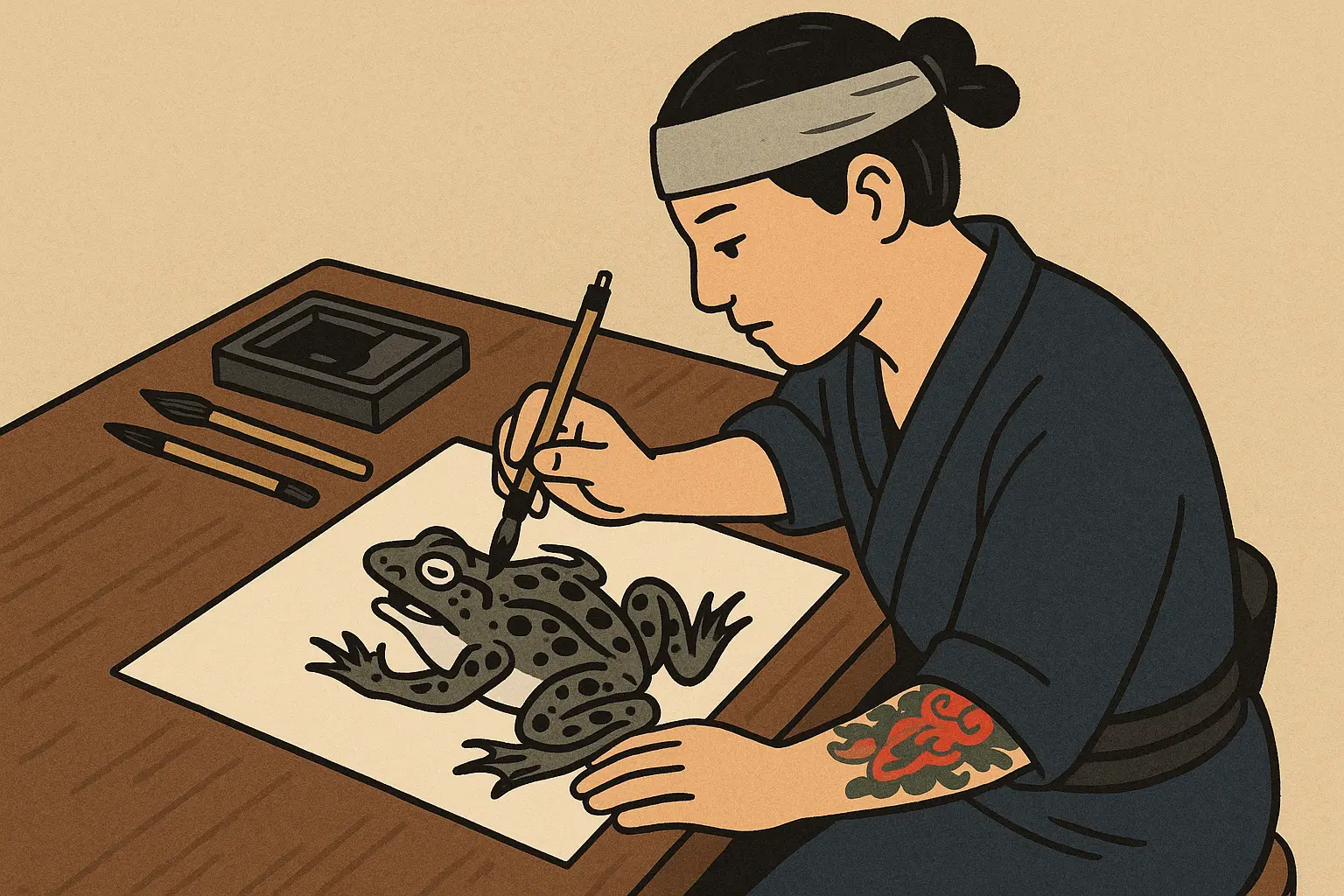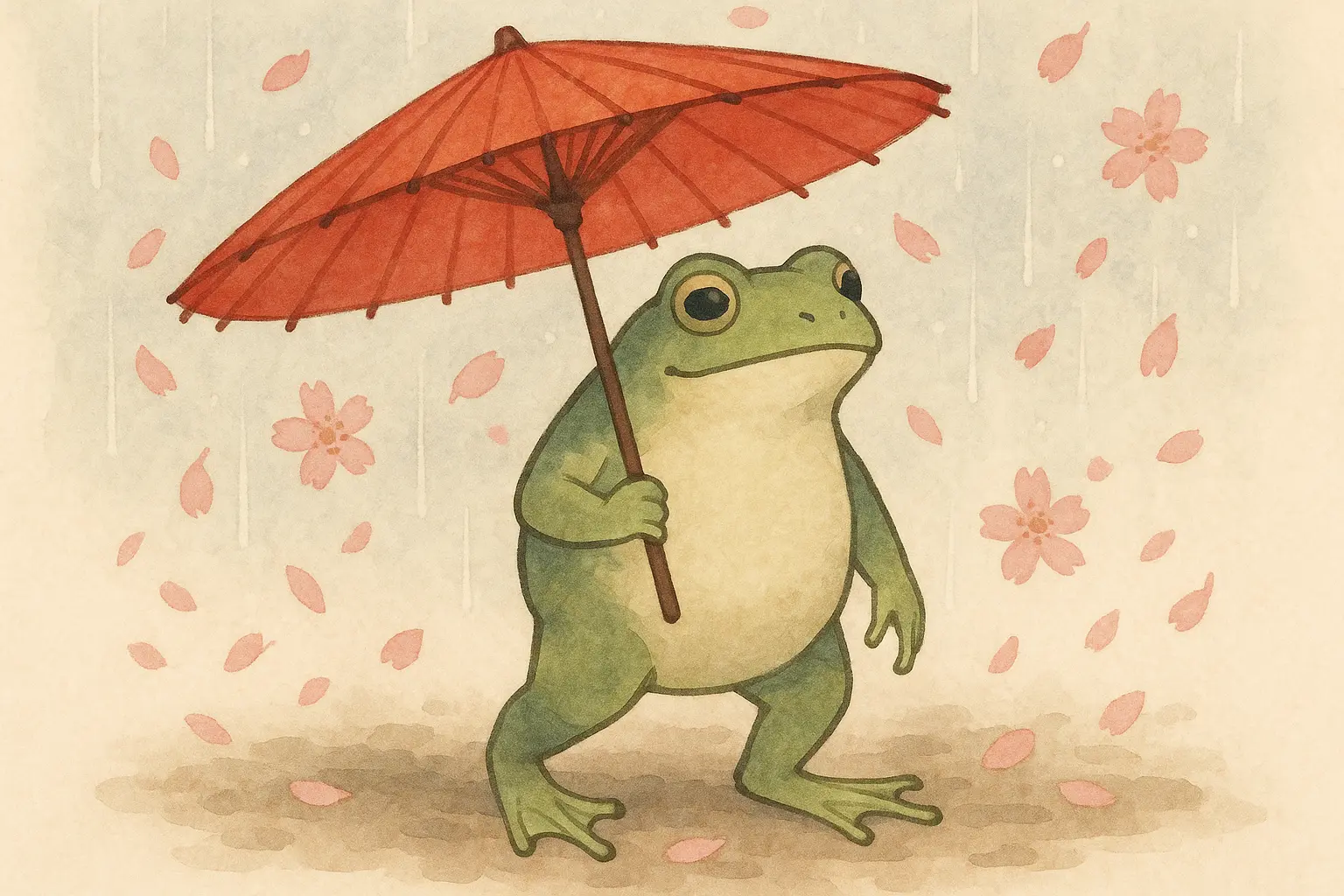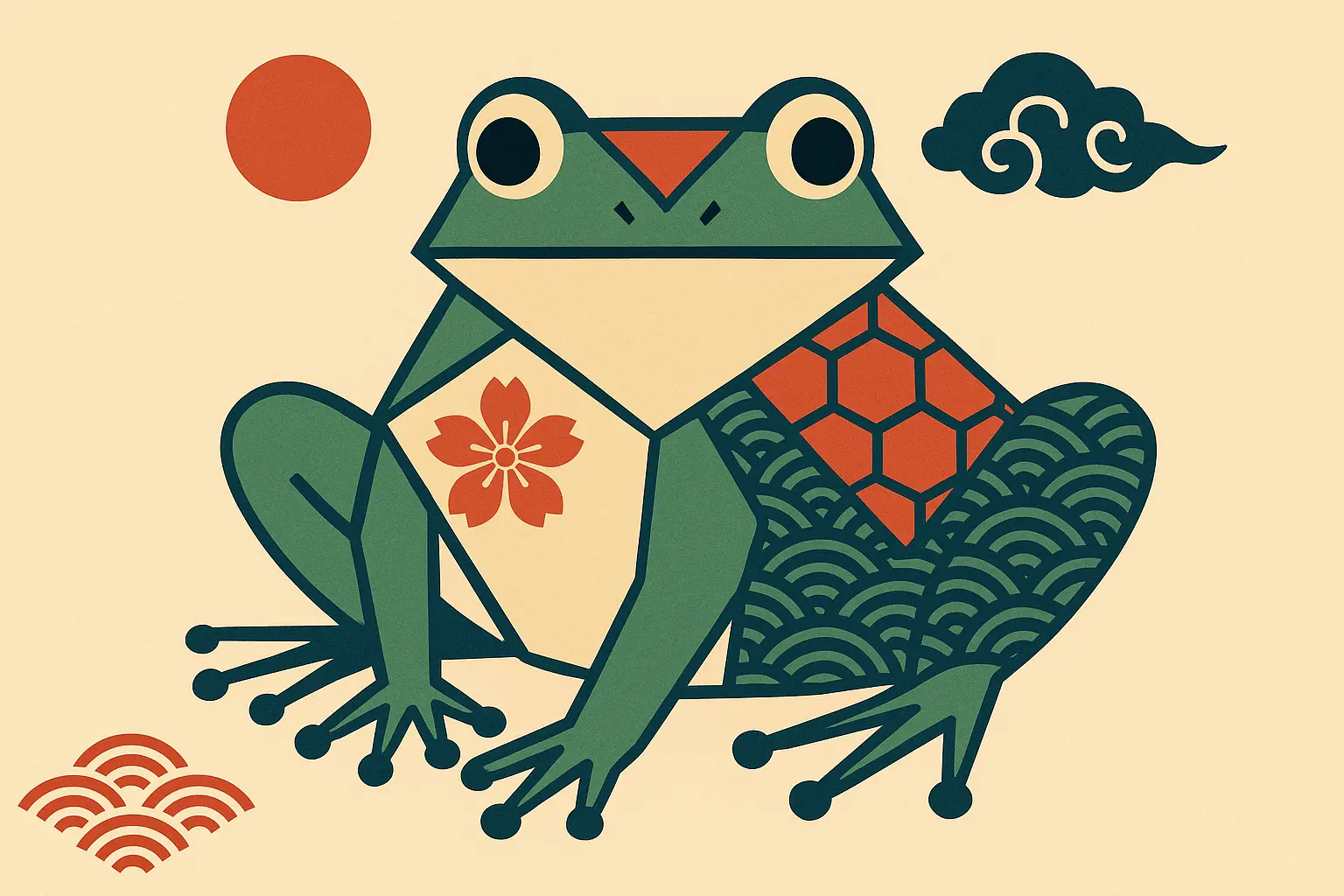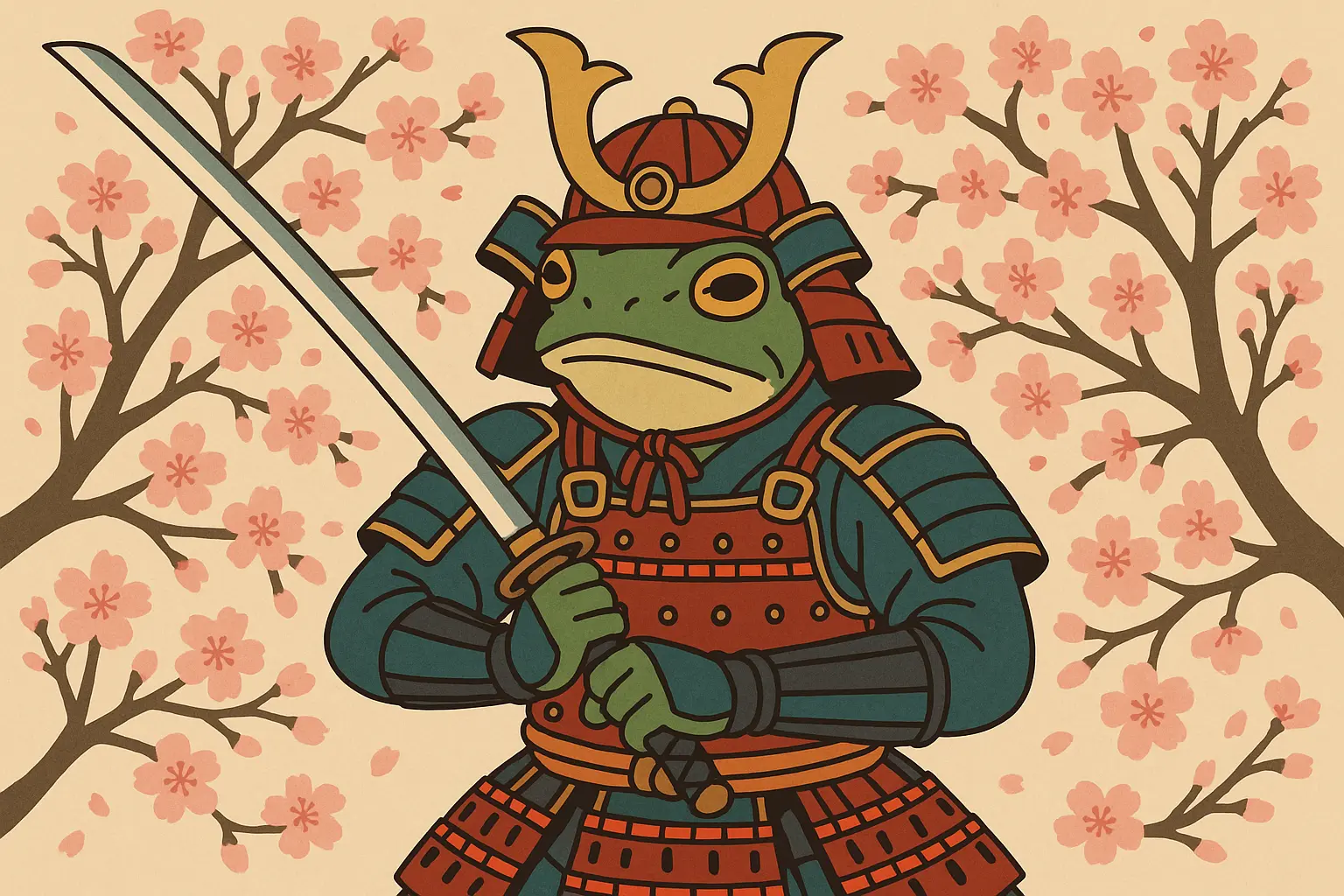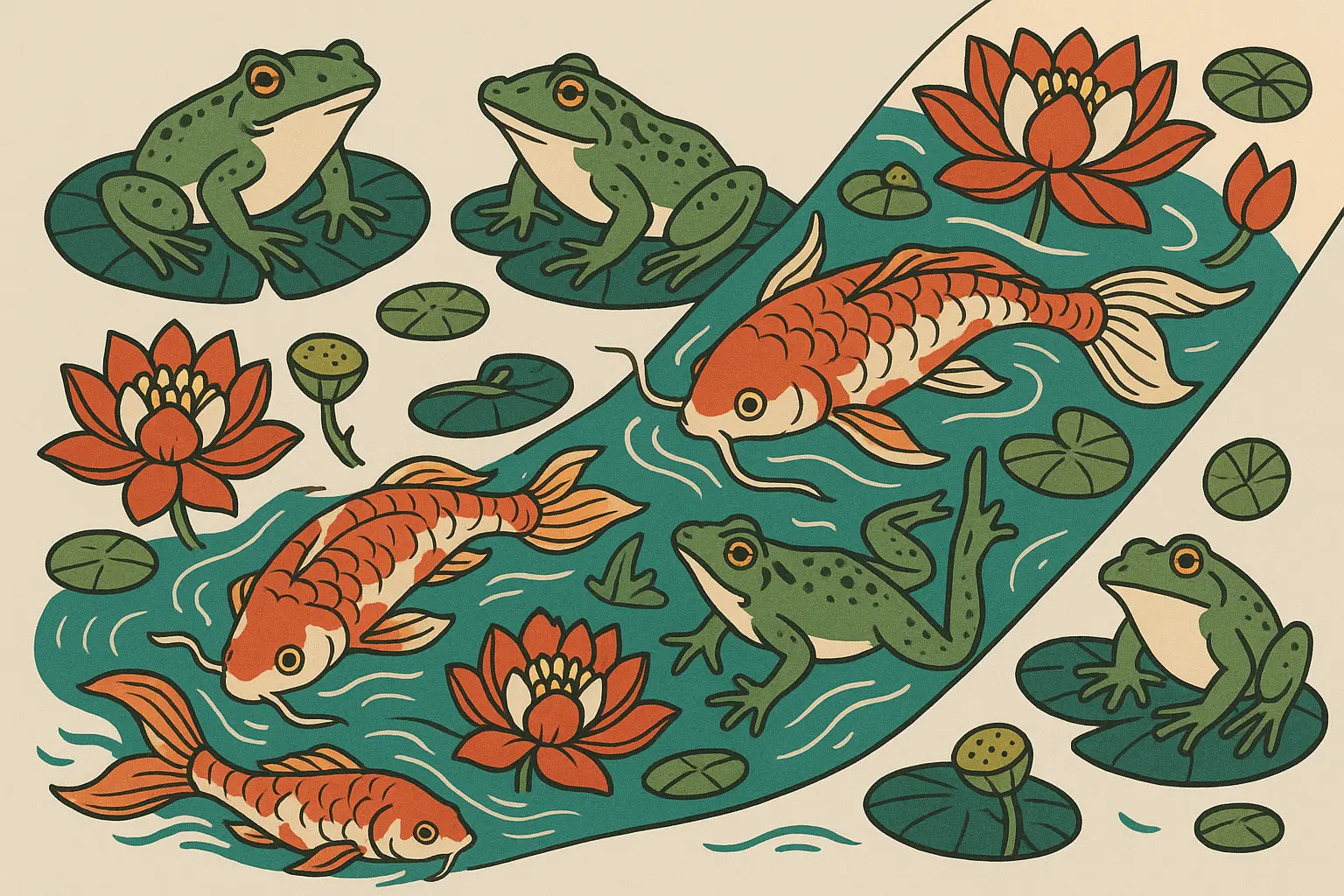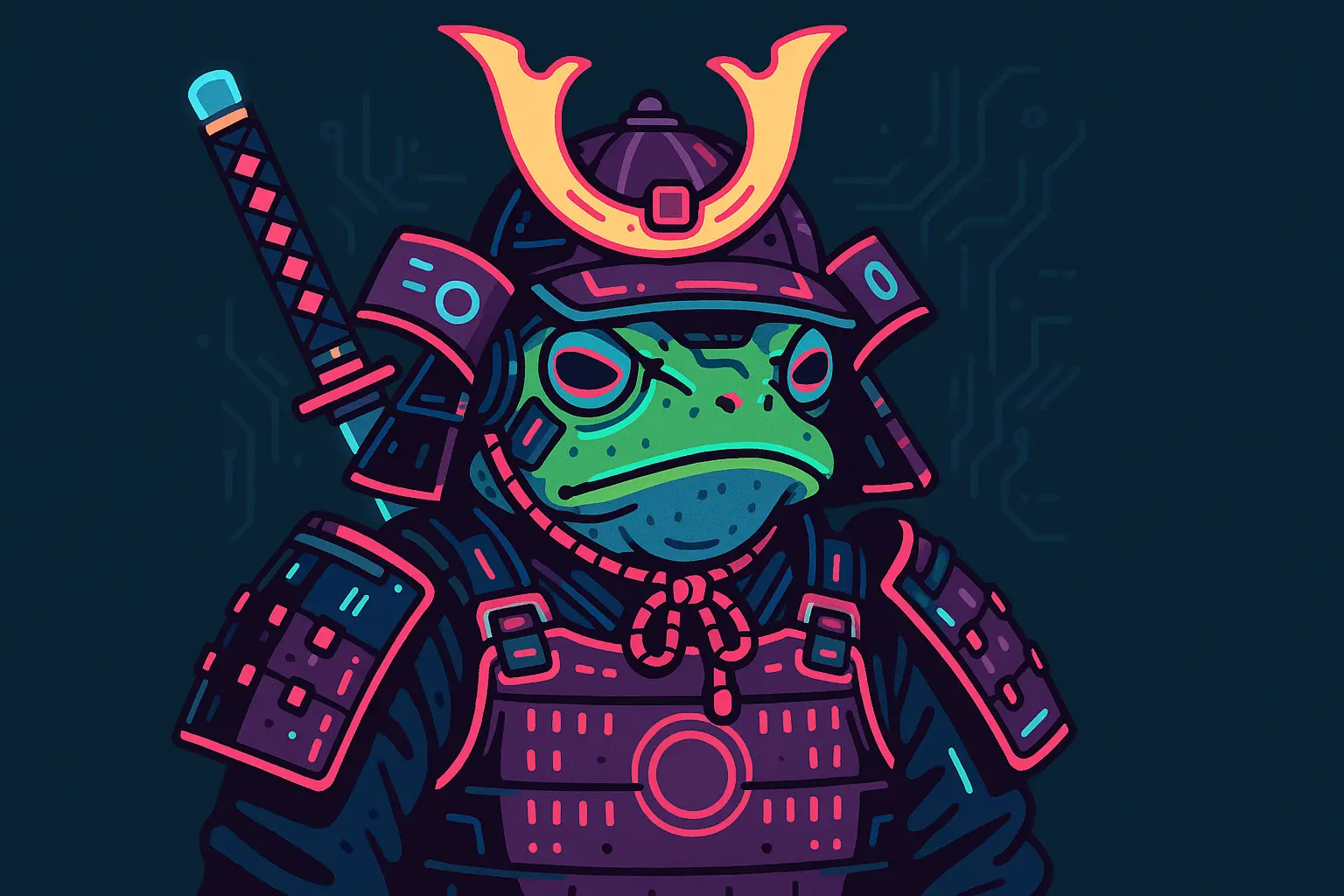25 Japanese Frog Tattoo Ideas Worth Considering
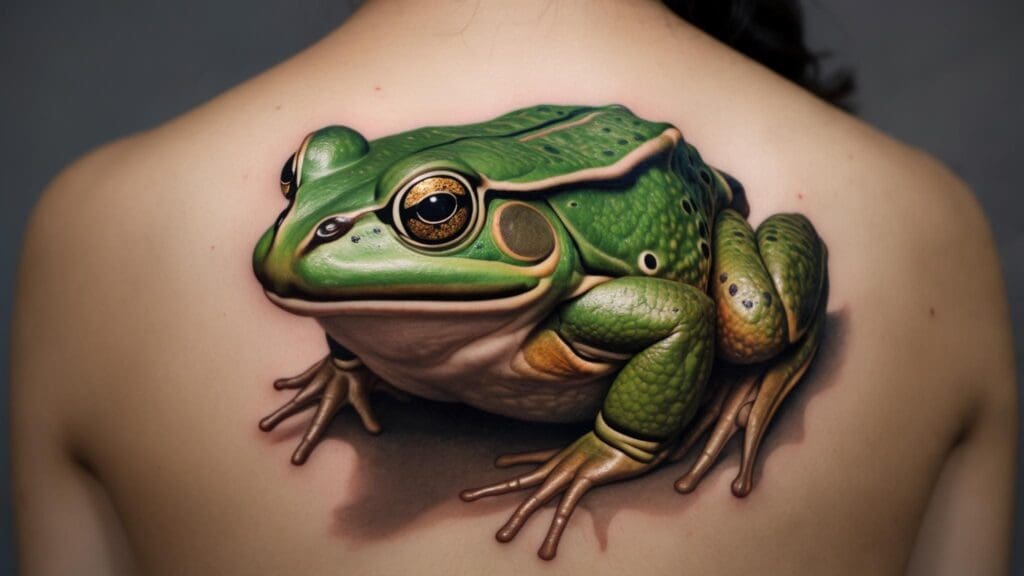
Frogs hold tremendous significance in Japanese tattooing, with traditional designs dating back to the Heian Period (794-1185) according to Ink Happened’s cultural analysis. I remember walking through a traditional Japanese garden in Kyoto, watching koi swim beneath lily pads where small frogs perched peacefully – that moment crystallized why these creatures represent such powerful transformation symbolism in Japanese culture.
Here’s what’s really cool about frog tattoos in Japanese culture – there’s way more meaning than you might expect. The word “kaeru” means both “frog” and “to return” in Japanese, making these japanese frog tattoo designs perfect for anyone seeking symbols of safe passage, good fortune, or personal metamorphosis. Understanding the frog tattoo meaning in Japanese culture reveals layers of symbolism that extend far beyond simple decoration. These japanese frog tattoo pieces connect you to centuries of cultural wisdom while expressing your personal journey of change.
Table of Contents
-
Essential Considerations for Japanese Frog Tattoos
-
Traditional Japanese Frog Designs (5 Designs)
-
Neo-Traditional Japanese Interpretations (4 Designs)
-
Samurai Frog Warrior Designs (5 Designs)
-
Large Format and Sleeve Designs (4 Designs)
-
Modern Japanese Frog Interpretations (4 Designs)
-
Small and Detailed Frog Designs (3 Designs)
-
Design Performance Analysis
-
Lifestyle and Goal Matching
-
Final Thoughts
TL;DR
Japanese frog tattoos carry deep cultural meaning – “kaeru” means both “frog” and “to return,” symbolizing good fortune, transformation, and safe passage. Traditional designs with bold outlines and proper shading techniques age better than experimental styles and require experienced japanese frog tattoo artists.
Samurai frog combinations merge warrior symbolism with transformation themes, creating powerful masculine designs that need larger placement areas. Sleeve and large format pieces allow maximum traditional detail but require significant time and budget investment over multiple sessions.
Small designs offer professional flexibility and lower costs while maintaining cultural authenticity through simplified traditional elements. Color choice affects meaning – greens represent nature and renewal, blues symbolize tranquility, reds indicate passion or protection. Placement impacts both cultural authenticity and practical considerations including professional visibility and aging characteristics.
Essential Considerations for Japanese Frog Tattoos
Look, before you fall in love with any specific design, let’s talk about the stuff that actually matters. I’ve seen too many people rush into Japanese tattoos without thinking through the basics, and trust me – you don’t want to be that person explaining to friends why your “traditional” frog looks like it came from a coloring book.
Cultural Significance and Symbolic Depth
Here’s the thing about Japanese frog tattoos – they’re not just cute animals on your skin. The whole “kaeru” thing I mentioned earlier? It’s actually pretty profound when you think about it. Imagine having a tattoo that literally means “I always find my way home” and “good things are coming my way” at the same time. That’s some heavy symbolism packed into one little amphibian.
I remember talking to this guy at a tattoo convention who had a beautiful traditional frog piece on his shoulder. He told me he got it right after his divorce – not because he was trying to be deep or anything, but because he genuinely needed a reminder that he could start over and things would get better. Three years later, he met his current wife. Coincidence? Maybe. But he swears by that frog.
The cultural stuff isn’t just for show either. Traditional Japanese culture sees frogs as protective spirits for travelers. So if you’re someone who moves around a lot for work, or you’re just starting a new chapter in life, this symbolism actually makes sense. It’s not like getting a random butterfly because it looks pretty.
|
Symbolic Element |
Traditional Meaning |
Modern Interpretation |
|---|---|---|
|
Kaeru (Frog) |
Safe return home, good fortune |
Personal transformation, new beginnings |
|
Cherry Blossoms |
Life’s fleeting beauty |
Embracing change, living in the moment |
|
Koi Fish |
Perseverance, strength |
Overcoming obstacles, determination |
|
Lotus Flowers |
Purity, spiritual awakening |
Rising above challenges, enlightenment |
|
Rain Elements |
Renewal, life-giving water |
Cleansing, fresh starts |
|
Temple/Garden Setting |
Sacred space, harmony |
Inner peace, spiritual growth |
Artistic Authenticity Requirements
Okay, this is where things get real. Not every tattoo artist can do Japanese work properly, and the difference between authentic Japanese tattooing and “Japanese-inspired” work is like the difference between sushi from Tokyo and a California roll from the gas station. Both might be fine, but they’re completely different things.
Real Japanese tattooing has specific techniques that most Western artists never learn. There’s this shading method called bokashi that creates these incredible gradients – it’s what makes the difference between a flat-looking tattoo and one that seems to glow from within. Then there are traditional ways of incorporating water, wind, and other elements that follow rules developed over centuries.
Sarah’s story is a perfect example of what can go wrong. She went to a regular tattoo shop and asked for a “Japanese frog.” The artist was talented but had never studied Japanese techniques. The result looked more like a realistic frog with some Asian-ish waves around it. Not terrible, but definitely not what she wanted. She ended up spending twice as much to get it covered up by someone who actually knew what they were doing.
Here’s how to avoid that mess: Ask to see the artist’s Japanese portfolio specifically. If they don’t have one, or if their Japanese work looks like regular tattoos with some cherry blossoms thrown in, keep looking. A real Japanese tattoo specialist will be excited to talk about traditional techniques and show you examples of proper line weights, color relationships, and composition flow.
Placement and Sizing Strategy
This is where a lot of people mess up without realizing it. Japanese tattoos aren’t just pictures you stick anywhere on your body – they’re designed to work with your anatomy and energy flow. Sounds mystical, but it’s really about making sure your tattoo looks good and ages well.
Bigger is usually better with Japanese work because the traditional elements need space to breathe. Those intricate water patterns and detailed shading? They turn into blurry messes if you try to cram them into a 3-inch space. I’ve seen people try to fit a whole pond scene onto their wrist, and it just doesn’t work.
But here’s the thing – you don’t have to go huge right away. A well-placed small traditional frog can always be expanded into something larger later. The key is thinking ahead and not boxing yourself into a corner with poor placement.
Traditional Japanese Frog Designs
Alright, let’s get into the good stuff. These are the designs that have been making people happy for literally centuries. They’re not trendy or experimental – they’re time-tested classics that age like fine wine.
1. Classic Kaeru with Cherry Blossoms
This is probably what most people picture when they think “Japanese frog tattoo,” and there’s a good reason for that – it works. You’ve got your bright green frog sitting among falling sakura petals, maybe some traditional wind bars and water ripples to tie it all together.
The size sweet spot is usually 8-10 inches. Any smaller and you lose the detail that makes it special. Any bigger and you’re getting into serious real estate territory. The colors are where this design really shines – those deep greens against soft pink petals with traditional blue water elements create this harmony that just feels right.
What I love about this design is how the symbolism layers together. Cherry blossoms are all about appreciating life’s fleeting moments, while the frog represents renewal and good fortune. So you’re basically wearing a reminder to embrace change and find beauty in transitions. Pretty heavy for something that looks so cheerful.
2. Frog on Lily Pad with Koi Elements
Now we’re talking about a full pond ecosystem. This one features a golden frog chilling on a lily pad, with koi swimming around and maybe some lotus flowers to complete the scene. It’s like having a peaceful Japanese garden permanently on your body.
This design packs a lot of cultural punch because you’re combining multiple Japanese symbols. Koi represent perseverance and strength, lotus flowers symbolize purity and spiritual awakening, and the frog adds transformation and prosperity themes. It’s like a greatest hits album of Japanese symbolism.
The downside? This is a complex piece that’s going to take multiple sessions and cost some serious money. But if you want traditional Japanese work that tells a complete story, this is hard to beat.
3. Rainy Season Frog with Umbrella
This one’s my personal favorite because it’s got personality. Picture a cute frog holding a traditional Japanese umbrella in falling rain, with those classic rain line techniques that Japanese artists have perfected over generations.
The seasonal connection here is beautiful – rainy season in Japan represents renewal, growth, and life-giving water. The umbrella adds this protection element while keeping things playful. It’s perfect for people who want traditional symbolism without taking themselves too seriously.
Size-wise, this works well at 5-8 inches, which gives you more placement flexibility than some of the larger designs. It’s also a good middle ground for artists – complex enough to showcase traditional techniques but not so crazy that you need a master-level artist.
4. Temple Guardian Frog
Okay, this one’s for people who want their frog to look like it could kick some ass. Instead of cute and peaceful, we’re talking about a frog depicted in the style of those fierce temple guardian statues you see at Japanese temples.
This is a large format design – think 10-15 inches minimum – because you need space to capture that fierce expression and traditional cloud background properly. The guardian aspect transforms typical frog symbolism into something more protective and powerful.
It appeals to people who want strength-based imagery while keeping the transformation themes. The complexity means you’re limited to larger body areas, but the visual impact makes it worth the space commitment.
5. Seasonal Transformation Frog
This design shows a frog surrounded by autumn maple leaves with traditional seasonal elements. Red and gold color schemes with traditional shading techniques create something that feels both timeless and specifically tied to a moment in the year.
Seasonal symbolism adds this temporal depth to the transformation themes – autumn represents change, maturity, and preparation for renewal. The traditional color palette ages incredibly well, and the moderate complexity makes it accessible to experienced artists without requiring master-level expertise.
Neo-Traditional Japanese Interpretations
These designs are for people who love Japanese symbolism but want something that feels more contemporary. They respect the cultural foundations while incorporating modern artistic techniques that reflect current tattoo trends.
6. Geometric Pattern Frog
This combines traditional frog imagery with modern geometric patterns and sacred geometry elements. You get mathematical precision mixed with organic frog forms, creating something that honors tradition while appealing to contemporary aesthetic preferences.
The geometric elements actually provide excellent aging potential – those bold geometric shapes stay crisp over time. It requires an artist skilled in both traditional Japanese techniques and modern geometric precision, which can be a challenge to find.
7. Watercolor Wash Frog
Traditional frog silhouette with watercolor background effects and Japanese calligraphy elements. The watercolor technique adds this artistic fluidity while maintaining structural integrity through traditional line work.
Here’s the honest truth about watercolor tattoos – they look amazing when fresh but may need touch-ups over time compared to traditional solid color applications. The key is having bold black outlines for the main elements so even if the watercolor fades a bit, the tattoo still looks intentional.
Marcus went this route for his forearm piece. Two years later, the bold outlines are still crisp while the watercolor elements have developed this natural weathered appearance that actually enhances the artistic quality. Sometimes aging gracefully is better than fighting it.
8. Minimalist Line Art Frog
This approach reduces visual complexity while maintaining cultural authenticity through proper proportional relationships and symbolic integration. Clean lines with selective traditional elements create something that feels both modern and respectful.
The aging characteristics are excellent because of the simplified approach, and you’re looking at lower session time and cost compared to complex traditional pieces. Despite the simplification, cultural elements remain intact through careful compositional choices.
9. Digital Art Inspired Frog
This contemporary interpretation incorporates pixel art or digital design elements with traditional Japanese frog symbolism. It’s like if traditional Japanese art met modern gaming culture and had a baby.
The digital art approach appeals to gaming and tech culture enthusiasts while maintaining Japanese symbolic meaning. It requires an artist familiar with translating digital art to tattoo medium, which is its own specialized skill. The unique aesthetic creates excellent conversation starter potential.
Samurai Frog Warrior Designs
Now we’re getting into some seriously badass territory. These designs merge warrior symbolism with transformation themes, creating powerful masculine imagery that appeals to people seeking strength-based Japanese tattoos.
10. Traditional Samurai Frog Warrior
This is the classic – a frog in full samurai armor with katana sword, featuring traditional armor details with proper Japanese military symbolism. We’re talking 12-18 inches minimum because you need space to properly render armor complexity and maintain cultural authenticity.
The cultural symbolism here combines warrior virtues with transformation themes, creating powerful masculine appeal. But let’s be real – this demands significant artistic expertise and budget commitment. You’re looking at multiple sessions and serious money, but when properly executed, the cultural authenticity and visual impact are incredible.
11. Frog Ronin with Cherry Blossoms
A frog depicted as a wandering ronin amid falling cherry blossoms creates this melancholic mood with traditional seasonal elements. The medium to large format (8-14 inches) allows for proper emotional expression while incorporating seasonal symbolism.
The ronin philosophy combined with transformation themes creates emotional resonance that appeals to people interested in samurai philosophy and personal journey narratives. Complex shading requirements for mood creation demand experienced artistic execution, but the emotional depth creates lasting personal meaning.
12. Battle Scene Samurai Frog
Dynamic action scene showing a samurai frog in combat with traditional enemies or mythical creatures. High energy composition with traditional battle elements. This is a complex design that requires multiple sessions and significant budget commitment but provides maximum visual impact.
The dynamic composition creates excellent storytelling potential while maintaining traditional Japanese battle imagery. Very complex design execution requires expert-level artistic skill and substantial time investment. The visual drama and cultural authenticity make this appealing for those seeking maximum impact Japanese tattoo work.
|
Design Category |
Complexity Level |
Session Time |
Budget Range |
Aging Quality |
|---|---|---|---|---|
|
Traditional (1-5) |
Medium |
4-8 hours |
$800-2000 |
Excellent |
|
Neo-Traditional (6-9) |
Medium-High |
5-10 hours |
$1000-2500 |
Good-Excellent |
|
Samurai (10-14) |
High |
8-15 hours |
$1500-4000 |
Excellent |
|
Large Format (15-18) |
Very High |
15-40 hours |
$3000-10000 |
Excellent |
|
Modern (19-22) |
Medium-High |
6-12 hours |
$1200-3000 |
Good |
|
Small Detailed (23-25) |
Low-Medium |
2-5 hours |
$400-1200 |
Good-Excellent |
13. Meditative Samurai Frog
This shows a peaceful samurai frog in meditation pose with traditional temple or garden background, emphasizing spiritual warrior aspects rather than combat themes. It appeals to both spiritual and martial interests while maintaining traditional Japanese aesthetic principles.
The balanced symbolism creates broader appeal by combining warrior strength with spiritual depth. Moderate complexity focuses on peaceful elements rather than battle scenes, making execution more manageable while maintaining cultural authenticity.
14. Armored Frog with Clan Symbols
Traditional frog samurai incorporating specific clan mon (family crests) and detailed armor work. This highly personalized approach allows for meaningful family or cultural connection integration while maintaining cultural authenticity.
The personal symbolism aspect appeals to those with Japanese cultural connections or those seeking deeply meaningful warrior imagery. Historical accuracy requirements demand research and cultural knowledge for proper execution.
Large Format and Sleeve Designs
These are the ultimate Japanese tattoo experiences – comprehensive compositions that tell complete stories through integrated symbolism. They require significant time and budget investment but provide the full traditional Japanese tattoo experience.
15. Full Sleeve Pond Ecosystem
This is the holy grail – a comprehensive japanese frog tattoo sleeve depicting complete pond environment with multiple frogs, koi, lotus flowers, and seasonal elements. Traditional Japanese composition flows around arm contours, creating an immersive natural scene.
This represents the ultimate traditional Japanese tattoo experience, requiring significant time and budget investment over multiple sessions. We’re talking months of work and thousands of dollars, but the cultural authenticity and visual impact are unmatched.
16. Half Sleeve Rain and Frog Scene
A Japanese frog tattoo sleeve focusing on rainy season themes with frogs, rain patterns, and traditional umbrella elements that flow naturally with arm anatomy. Strong seasonal symbolism creates cohesive narrative while maintaining traditional Japanese compositional principles.
This serves as a good introduction to Japanese sleeve tattooing while maintaining cultural authenticity. It requires an artist experienced in Japanese composition and traditional rain pattern techniques, but it’s more manageable than a full sleeve commitment.
17. Back Panel Frog Garden
Large back piece depicting traditional Japanese garden with central frog figure, incorporating traditional landscape elements, bridges, and seasonal flowers. Maximum canvas space allows for detailed traditional elements and comprehensive storytelling.
Maximum canvas space provides opportunity for detailed traditional elements and master-level artistic showcase. This is the ultimate japanese frog tattoo statement piece, but it requires significant commitment in time and cost.
18. Leg Sleeve Transformation Theme
Lower leg sleeve showing frog lifecycle and transformation themes with traditional Japanese artistic interpretation of metamorphosis and seasonal progression. Unique biological symbolism combines with cultural interpretation to create meaningful transformation narrative.
This offers a unique alternative to traditional pond scenes while maintaining cultural authenticity. It’s a good alternative to arm sleeve placement for professional considerations, and the transformation theme appeals to those seeking personal growth symbolism.
Modern Japanese Frog Interpretations
These contemporary designs push creative boundaries while maintaining respect for Japanese cultural foundations, incorporating elements from cyberpunk, anime, street art, and abstract geometric styles.
19. Cyberpunk Frog Samurai
Futuristic interpretation of samurai frog with technological elements while maintaining traditional composition principles. Neon colors combine with traditional shading techniques to create unique fusion of traditional and contemporary themes.
This creates conversation starter potential with strong visual impact. It appeals to sci-fi and gaming enthusiasts while maintaining cultural respect through traditional compositional elements. Requires an artist skilled in both traditional Japanese and contemporary techniques.
20. Anime-Influenced Frog Design
Japanese frog tattoo incorporating anime and manga artistic styles while respecting traditional symbolism. Large eyes and contemporary character design elements maintain cultural respect while embracing contemporary Japanese art forms.
This appeals to anime and manga enthusiasts while maintaining cultural authenticity through symbolic respect. Good aging potential results from bold line work characteristic of anime art translation to tattoo medium.
21. Street Art Style Frog
Urban interpretation combining traditional frog symbolism with street art aesthetics, featuring graffiti-inspired elements with traditional Japanese composition. Contemporary urban aesthetic maintains cultural foundation while appealing to street art enthusiasts.
This offers a unique artistic approach that stands out from traditional designs. It appeals to street art enthusiasts while maintaining cultural symbolic foundation, but requires specialized artist familiar with both techniques.
22. Abstract Geometric Frog
Highly stylized japanese style frog tattoo using abstract geometric shapes while maintaining traditional Japanese color schemes and symbolic elements. Modern artistic interpretation appeals to contemporary art enthusiasts while preserving cultural foundations.
Modern artistic interpretation creates unique aesthetic appeal for contemporary art enthusiasts. Excellent aging characteristics result from geometric boldness and traditional color foundation.
Small and Detailed Frog Designs
These compact designs prove that cultural authenticity and meaningful symbolism don’t require large canvas space, offering excellent entry points into Japanese tattooing.
23. Miniature Traditional Frog
Small-scale japanese frog tattoo maintaining traditional elements in compact format, perfect for wrist, ankle, or behind-ear placement. Optimal 2-4 inch size provides excellent introduction to Japanese tattooing with lower cost and time commitment.
This is an excellent introduction to Japanese tattooing with lower financial and time commitment. Good aging potential results from simplified traditional elements that maintain visual impact at small scale.
24. Delicate Frog with Calligraphy
Small frog design accompanied by Japanese calligraphy of meaningful words or phrases, combining visual and textual traditional elements. Personal meaning integration allows for customized cultural connection.
Jennifer’s story about getting the Japanese character for “transformation” with her wrist frog shows how powerful this combination can be. Her artist researched proper calligraphy stroke order and traditional brush techniques to ensure authentic character execution. The combination created a personal connection to her career transition while maintaining cultural respect and professional appropriateness.
25. Matching Pair Small Frogs
Set of two complementary small frog designs for couples or personal symmetry, featuring traditional elements adapted for small scale execution. This unique approach offers couples option or personal symmetry preferences.
Lower individual cost allows for budget-friendly traditional Japanese tattoo experience. Good aging potential through simplified traditional elements that maintain visual impact over time.
Design Performance Analysis
Let’s get real about what actually matters when you’re choosing your design. I’ve seen too many people get caught up in what looks cool on Pinterest without thinking about how their tattoo will perform in the real world.
Traditional designs score highest for cultural authenticity because they follow established Japanese artistic conventions. If you want something that a Japanese tattoo master would nod approvingly at, stick with categories 1-5, 10-14, or 23-25. Neo-traditional and modern interpretations balance cultural respect with contemporary appeal, but they’re walking a tightrope – some pull it off beautifully, others end up looking like they’re trying too hard.
Here’s something most people don’t think about: complex designs require master-level Japanese tattoo artists, and those folks aren’t cheap or easy to find. If you’re set on a samurai battle scene or full sleeve ecosystem, you better start saving now and be prepared to travel to find the right artist. Moderate complexity designs can be handled by experienced artists with Japanese training, while simple designs are accessible to intermediate-level artists who’ve studied the techniques.
The aging game is where traditional bold-lined designs really shine. I’ve seen 20-year-old traditional Japanese pieces that still look crisp and vibrant, while some modern interpretations from just five years ago already look dated or blurry. Large format designs maintain visual impact longest because they have the space to age gracefully.
|
Placement Area |
Professional Visibility |
Pain Level |
Aging Characteristics |
Best Design Types |
|---|---|---|---|---|
|
Forearm |
Medium |
Low-Medium |
Excellent |
Traditional, Neo-traditional |
|
Upper Arm |
Low |
Low |
Excellent |
All categories |
|
Back/Shoulder |
Low |
Medium |
Excellent |
Large format, Samurai |
|
Chest |
Low |
High |
Good |
Traditional, Samurai |
|
Wrist/Ankle |
High |
Medium-High |
Good |
Small detailed only |
|
Leg/Thigh |
Low-Medium |
Medium |
Excellent |
Sleeves, Large format |
Lifestyle and Goal Matching
This is where you need to be brutally honest with yourself. I’ve met people with beautiful Japanese sleeves who work in corporate environments and spend half their energy hiding their ink, and others with tiny hidden pieces who wish they’d gone bigger. Neither situation is ideal.
If you’re in a conservative profession, smaller designs (23-25) or strategic placement areas make sense. Creative industries often embrace visible Japanese tattoo work, making medium to large japanese frog tattoo ideas viable options. But here’s the thing – think about your career trajectory. That tiny frog behind your ear might seem perfect now, but what if you get promoted to client-facing roles? Or what if you change careers entirely?
The transformation symbolism in frog tattoos really resonates with people going through major life changes. I’ve talked to folks who got their frog tattoos during divorces, career changes, recovery journeys, and other pivotal moments. There’s something powerful about wearing a symbol that literally means “good things are coming” when you’re in a tough spot.
For active outdoor lifestyles, you need designs that can handle sun exposure. Traditional bold-lined pieces perform best here. First-time tattoo recipients often start small and work their way up – there’s wisdom in that approach. Sleeve projects can be planned in phases over time, which spreads out the cost and commitment.
Final Thoughts
Japanese frog tattoos offer something special – meaningful cultural symbolism that celebrates transformation, good fortune, and safe passage through life’s changes. Whether you go traditional with kaeru imagery and cherry blossoms, badass with samurai frog warriors, or contemporary with respectful modern interpretations, you’re wearing a personal statement about growth and positive change.
The key to long-term satisfaction is understanding both the cultural significance and practical considerations. Traditional designs with proper artistic execution age beautifully and maintain cultural authenticity. Modern interpretations allow for personal expression within respectful cultural boundaries. Your choice should reflect your personal connection to the japanese frog tattoo meaning, lifestyle requirements, and aesthetic preferences.
But here’s the most important thing: Japanese frog tattoos represent more than decorative art. They’re symbols of transformation that can serve as daily reminders of your capacity for positive change and growth. Whether you start with a small traditional design or commit to a comprehensive sleeve composition, you’re participating in a rich cultural tradition that celebrates life’s continuous evolution and the good fortune that comes with embracing change.
Just remember – this isn’t just about looking cool. It’s about carrying meaningful symbolism that can genuinely impact how you see yourself and navigate life’s challenges. Choose wisely, find the right artist, and prepare for a piece of art that grows more meaningful over time.
